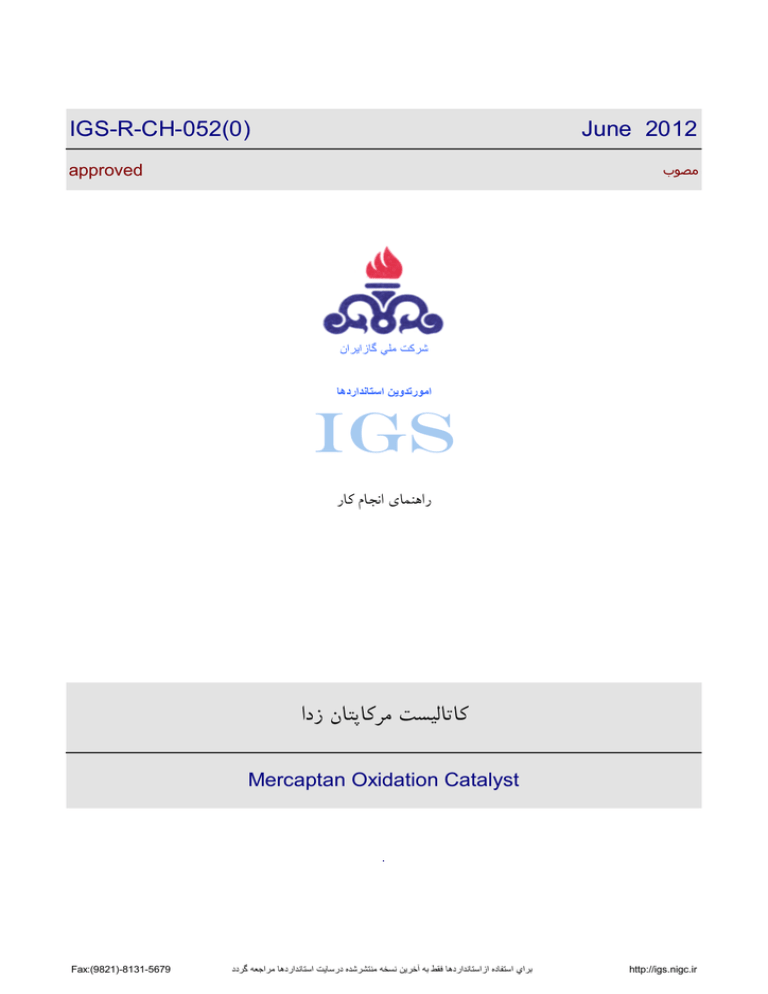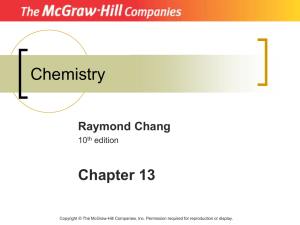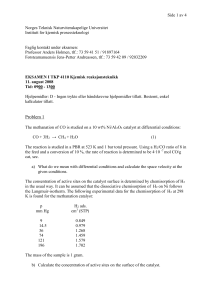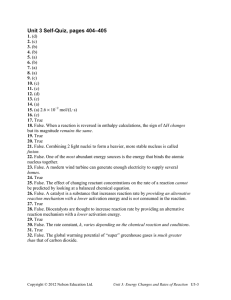IGS IGS-R-CH-052(0) June 2012
advertisement

IGS-R-CH-052(0) June 2012 approved !" #$ % IGS Mercaptan Oxidation Catalyst . Fax:(9821)-8131-5679 77 89: " ;7< => ?@ # @<7 A=% B?C" 8DE> F GH 8I JKL ;7< => ?@ A7 M?@ N I http://igs.nigc.ir N.I.G.C. June 2012 IGS-R-CH-052(0) FOREWORD This standard is intended to be mainly used by NIGC and contractors and has been prepared on interpretation recognized standards, technical documents, knowledge, backgrounds and experiences in gas industries at national and international levels. Iranian gas standards (IGS) are prepared, reviewed and amended by technical standard committees within NIGC Standardization division and submitted to the NIGC's "STANDARDS COUNCIL" for approval. IGS Standards are subject to revision, amendment or withdrawal, if required, thus the latest edition of IGS shall be checked/inquired by NIGC users. This standard must not be modified or altered by the end users within NIGC and her contractors. Any deviation from normative references and / or well known manufacturers specifications must be reported to Standardization division. Any comments from concerned parties on NIGC distributed IGS are welcome to technical standards committees and will receive serious attention and consideration should a revision to standards is recommended . GENERAL DEFINITIONS: Throughout this standard the following definitions, where applicable, should be followed: 1- "STANDARDIZATION DIV." has been organized to deal with all aspects of industrial standards in NIGC. Therefore, all queries for clarification or amendments are requested to be directed to mentioned div. 2- "COMPANY": refers to national Iranian gas company. 3- "SUPPLIER": refers to a firm who will supply the service, equipment or material to IGS specification whether as the prime producer or manufacturer or a trading firm. 4- "SHALL ": is used where a provision is mandatory. 5- "SHOULD": is used where a provision is advised only. 6- "MAY": is used where a provision is completely discretionary. ------------------------------------Website: http://igs.nigc.ir E-mail: igs@nigc.ir N.I.G.C. June 2012 IGS-R-CH-052(0) TABLE OF CONTENT 1. SCOPE 1 2. REFERENCE 1 3. DEFINITION 1 4. SYSTEM DESIGN 2 5. QUALIFICATION PROCEDURE 2 6. QUALITY ASSURANCE 2 7. APPLICABILITY 2 8. SAMPLES 3 9. INSPECTION 3 10. MARKING 4 11. PACKAGING 4 12. STORAGE LIFE 4 13. DOCUMENTATION 4 ANNEX A – Mercaptan Oxidation Catalyst Typical Properties 5 ANNEX B – Catalyst Data Sheet 6 ANNEX C – Mercaptan Removal Unit Data 7 ANNEX D – Gas Treating Plant Data 8 ANNEX E – Propane/Butane/LPG Treating Plant Data 13 ANNEX F – Test Methods 16 N.I.G.C. June 2012 IGS-R-CH-052(0) 1. SCOPE This standard specification provides the technical procedure for selection/substitution new mercaptan oxidation catalyst that is used for removing mercaptans from natural gas, LPG, butane and propane. 2. REFERENCE Throughout this standard specification the following standard is referred to. The editions of this standard that is in effect at the time of issues of this standard specification (2012) shall, to the extent specified herein, form part of this standard specification. The applicability of changes in standard that occur after the date of this standard specification shall be mutually agreed upon by the purchaser and the manufacturer/supplier. ISO 9001 (2008) "Quality Systems – Model for Quality Assurance in Design, Development, Production, Installation and Servicing” 3. DEFINITIONS 3.1 Mercaptan Oxidation Catalyst It is a proprietary catalytic chemical process used in natural gas, LPG, butane and propane processing plants to remove mercaptans by converting them to liquid hydrocarbon disulfides. 3.2 Extraction Unit A gas extraction unit is normally consisting of a combination column that includes prewash, extraction and water wash section while for liquids is normally including only an extractor column. 3.3 Regeneration Unit A caustic regeneration system will convert the extracted mercaptans to disulfide oil that is separated and removed while the regenerated caustic is returned to the extraction unit. 3.4 Technical Approved The technical approved is the first step for qualification of catalyst which technical information has been evaluated and approved by technical division. 3.5 Laboratory Approved The laboratory approved is the second step for qualification of catalyst which has passed laboratory tests. 3.6 Test Field Approved The test field approved is the third step for qualification of catalyst which has passed the operational test. 1 N.I.G.C. June 2012 IGS-R-CH-052(0) 4. SYSTEM DESIGN The manufacturer/supplier shall submit catalyst to be able oxidation of mercaptans to disulfides in mercaptan removal units as specified in Annex C. The manufacturer/supplier shall give full details of the proposed catalyst including chemical base and its characteristics as mentioned in Annex B. Note: Annexes D and E show typical questionnaires for mercaptan oxidation catalyst evaluation. 5. QUALIFICATION PROCEDURE The manufacturer/supplier shall pass following steps respectively as well as all requirements of this standard specification: 5.1 Technical Approved (Step 1) The manufacturer/supplier of catalyst shall provide information including original technical catalogue, MSDS and manufacturing product data sheet. The technical division shall evaluate information. The catalyst shall be approved by technical division. 5.2 Laboratory Approved (Step 2) The manufacturer/supplier that approved by technical division shall provide sufficient sample for laboratory tests. The laboratory tests will consist of laboratory tests which are performed in local laboratory and/or accredited laboratory. The catalyst shall be passed these tests. Note: Laboratory tests are given in Table A-1 of Annex A. Table A-1 provides typical properties for catalysts that have been used in natural gas refineries and presents guidelines for establishing minimum requirements for entering to step 3. 5.3 Field Test Approved (Step 3) The manufacturer/supplier that passed laboratory tests shall provide sufficient amount of catalyst for a 90 days period of operational test. The catalyst shall be passed operational test. 6. QUALITY ASSURANCE The manufacturer/supplier shall set up and maintain a quality assurance system for product supplied. The purchaser shall have the right to undertake inspection and testing of the products to ensure compliance with requirements of this standard specification. 7. APPLICABILITY The catalyst shall be easily applicable when used for loading into the system without any impractical effort. 2 N.I.G.C. June 2012 IGS-R-CH-052(0) 8. SAMPLES 8.1 Laboratory Test Sample Laboratory test sample shall consist of sufficient amount of catalyst that shall be forwarded to the purchaser for laboratory tests. Samples shall be plainly identified by attached durable tag marked with at least the following information: - Manufacturer's/Supplier's Name - Brand Name - Description - Date of Manufacture 8.2 Operational Test Sample Operational test samples shall consist of sufficient amount of catalyst that shall be forwarded to the purchaser for operational test. Samples shall be plainly identified by attached durable tag marked with at least the following information: - Manufacturer's/Supplier's Name - Brand Name - Description - Instruction for Use - Analytical Control - Dosage (with reference to Annex C) - Storaging - Date of Manufacture 9. INSPECTION The manufacturer/supplier shall be responsible for carrying out all the tests required by this standard specification, using his own or other reliable facilities, and he shall maintain complete records of all such tests and qualifications. Such records shall be available for review by the purchaser. The manufacturer/supplier shall furnish to the purchaser a certificate of quality stating that each batch has been sampled, tested, and qualified in accordance with this standard specification and has been found to meet the requirements specified. The manufacturer/supplier shall afford the purchaser’s inspector all reasonable facilities required for inspection of each batch of production in accordance with this standard specification. Such inspection in no way relieves the manufacturer/supplier of his responsibilities under the term of this standard specification. The purchaser reserves the right to perform any inspections set forth in this standard specification where such inspections are deemed necessary to assure that supplies and services conform to the prescribed requirements. The purchaser’s inspector reserve the right to have access to the materials subject to inspection for the purpose of witnessing selection of the samples, preparation of the test samples and performance of the test(s). For such tests, the inspector reserves the right to indicate the sample(s) from which the quantities will be taken in accordance with the provisions of this standard specification. 3 N.I.G.C. June 2012 IGS-R-CH-052(0) 10. MARKING 10.1 Marking of Containers Each container shall be legibly marked with at least following information: Composition MESC No. Handling Guidelines Safety Precautions Storage Conditions Date of Manufacture Date of expiry Batch No. Order No. Net weight Gross weight Name and Address of Manufacturer/Supplier HMIS (Hazardous Material Identification System including health, fire, reactivity, personal protection, specified hazard, etc) 10.2 Precautionary Marking All individual containers shall be marked with precautionary symbols and/or phrases. 11. PACKAGING 11.1 The catalyst shall be suitably packed in approved containers in accordance with the requirement of the purchase order. 11.2 The containers shall be protected against all damages or defects which may occur during handling. 12. STORAGE LIFE The catalyst shall meet all requirements of this standard specification at least 24 months from date of delivery at manufacturer's/supplier's mentioned storage condition. 13. DOCUMENTATION The manufacturer/supplier shall provide sufficient information and shall supply the technical information as a minimum requirement as follows: - ISO 9001 for management quality control of offered mercaptan oxidation catalyst that be used for removing mercaptans from natural gas, LPG, butane and propane issued by an internationally recognized body. - Approval test report, original technical catalogues, manufacturing product data sheet and application procedure recommendation and guidelines. - Material Safety Data Sheet (MSDS). - Filled, signed and stamped data sheet stating in Annex B. 4 N.I.G.C. June 2012 IGS-R-CH-052(0) "ANNEX A" Mercaptan Oxidation Catalyst Typical Properties Table A-1 provides typical properties for catalyst specified in this standard specification and have been used in natural gas refineries. Table A-1 Item Characteristic Unit Value Test Method 1 Chemical formula --- Sulfonated Cobalt Phthalocyanine IR 2 Appearance --- suspended liquid, dark blue color, without smell or sometimes a little ammonia smell Visual 3 Cobalt content wt % >5 Annex F clause F.1 4 Solid content wt % >15 Adjustable 5 Ash percent of solid content wt % <15 Annex F clause F.2 6 Water content wt % <85 Adjustable 7 Density g/cm3 1.05 – 1.2 Routine Procedure 8 pH --- 5–8 Routine Procedure 9 UV absorbance at λ max --- ≥3 at 667 nm Annex F clause F.3 10 Reduction of mercaptan in condensate ppm <50 Annex F clause F.4 11 Reduction of mercaptan in naphtha and LPG ppm <8 Annex F clause F.4 in liquid phase 5 N.I.G.C. June 2012 IGS-R-CH-052(0) "ANNEX B" Catalyst Data Sheet The following Tables shall be filled, signed and stamped by manufacturer/supplier. Product designation Manufacturer's/Supplier's name Manufacturer's/Supplier's address Table B-1 Item Characteristic 1 Chemical formula 2 Appearance 3 Co content 4 Solid content 5 Ash percent of solid content 6 Water content 7 Density 8 pH 9 UV absorbance at max 10 Reduction of mercaptan in condensate 11 Reduction of mercaptan in naphtha and LPG Unit Value Test Method Remark Notes: 1. This data sheet shall be filled, signed, and stamped by manufacturer/supplier. 2. Any deviation from this standard specification shall clearly be specified by manufacturer/supplier at following table. DEVIATION(S) AUTORIZED SIGNATURE COMPANY'S STAMP 6 N.I.G.C. June 2012 IGS-R-CH-052(0) "ANNEX C" Mercaptan Removal Unit Data The following Tables shall be filled by user. 1. Feed Gas/Liquid Composition: Characteristic N2 C1 C2 C3 iC4 nC4 iC5 nC5 C6 C7 C8 C9 C10+ H2S Total sulfur CO2 Total RSH C1SH C2SH iC3SH sec C4SH Unit mol % mol % mol % mol % mol % mol % mol % mol % mol % mol % mol % mol % mol % mol ppm mol ppm mol ppm mol ppm mol ppm mol ppm mol ppm mol ppm Value Unit bar gauge 0 C Value Unit ppm ppm Value 2. Inlet Gas/Liquid Condition: Characteristic Pressure Temperature 3. Outlet Gas/Liquid Specification: Characteristic Mercaptan Total sulfur 7 N.I.G.C. June 2012 IGS-R-CH-052(0) "ANNEX D" Gas Treating Plant Data (Informative) The following Tables could be filled by user and manufacturer/supplier for mercaptan oxidation catalyst evaluation for field test approval. 1. EXTRACTION UNIT 1.1 Operational Report 1.1.1 Flow rate, per hour Characteristic Feed gas Fresh prewash caustic Caustic to gas line Recycle caustic to prewash section Recycle plus spillback Lean caustic to prewash section Fresh water Circulating water Lean caustic to extraction section Unit MMSm3 m3 m3 m3 m3 m3 m3 m3 m3 Value 1.1.2 Pressure, bar gauge Characteristic Value Feed gas Product gas Prewash caustic break tank Recycle pump discharge Interface pot Lean caustic break tank Lean caustic pump discharge Circulating water pump discharge 1.1.3 Temperature, 0C: Characteristic Value Feed gas 8 N.I.G.C. June 2012 IGS-R-CH-052(0) 1.1.4 Calculated data: Characteristic Lean caustic (prewash section)/feed gas ratio Carbonate content Unit --- Value wt% spent caustic 1.2 Analyses Report 1.2.1 Feed gas composition: Characteristic Unit mol % mol % mol % mol % mol % mol % mol % mol % mol % mol % mol % mol % mol % mol ppm mol ppm mol ppm mol ppm mol ppm mol ppm mol ppm mol ppm N2 C1 C2 C3 iC4 nC4 iC5 nC5 C6 C7 C8 C9 C10+ H2S Total sulfur CO2 Total RSH C1SH C2SH iC3SH sec C4SH Value 1.2.2 Prewashed gas composition, mol ppm: Characteristic Value CO2 1.2.3 Treated product gas composition, mol ppm: Characteristic CO2 H2S Total sulfur Total RSH Value 9 N.I.G.C. June 2012 IGS-R-CH-052(0) 1.2.4 Calculated feed gas composition data: Characteristic Molecular weight Water content Unit --mol % Value 1.2.5 Other calculated data, kg/h: Characteristic Mercaptan-sulfur extracted Disulfide-sulfur reentered Value 1.2.6 Prewash stage effluent caustic: Characteristic Specific gravity Total alkalinity Strong base Mercaptide Sulfide Unit --wt% NaOH wt% NaOH wt% Sulfur wt% Sulfur Value 1.2.7 Extraction stage rich caustic, wt ppm sulfur: Characteristic Mercaptide Sulfide Value 1.2.8 Water-wash stage effluent water Characteristic Value pH 2. REGENERATION SECTION 2.1 Operational Report 2.1.1 Flow rate, per hour: Characteristic Unit Sm3 Sm3 m3 m3 Total air Mixed gas to burner Catalyst solution Lean caustic 10 Value N.I.G.C. June 2012 IGS-R-CH-052(0) 2.1.2 Pressure, bar gauge: Characteristic Catalyst pump discharge Rich caustic surge drum Oxidiser inlet Oxidiser outlet Air separator Value 2.1.3 Temperature, 0C: Characteristic Oxidiser inlet Oxidiser outlet Value 2.1.4 Calculated data: Characteristic Number of contactor(s) at service Total sulfur load Theoretical air need Excess air used Total gas treated Catalyst used Total fresh caustic Caustic soda used Total caustic to contactor Caustic to oxidiser Unit --kg/h Sm3/h volume % Sm3/h kg/MMSm3 m3/h kg/MMSm3 m3/h m3/h Value Unit --wt% NaOH wt% NaOH wt ppm Sulfur wt ppm Sulfur wt ppm Sulfur wt ppm Value 2.2 Laboratory Analyses 2.2.1 Lean caustic, regenerated: Characteristic Specific gravity Total base Strong base Mercaptide Sulfide Thiosulfate Extractible-sulfur 11 N.I.G.C. June 2012 IGS-R-CH-052(0) 2.2.2 Mixed caustic to oxidiser, wt ppm sulfur: Characteristic Mercaptide Sulfide Value 2.2.3 Spent air system, volume %: Characteristic Vented air, O2 content Air + Fuel gas blend, O2 Value 2.2.4 Field test, second: Characteristic Lean caustic shake test Value 12 N.I.G.C. June 2012 IGS-R-CH-052(0) "ANNEX E" Propane/Butane/LPG Treating Plant Data (Informative) The following Tables could be filled by user and manufacturer/supplier for mercaptan oxidation catalyst evaluation for field test approval. 1. EXTRACTION UNIT 1.1 Operational Report 1.1.1 Flow rate, m3 per hour Characteristic Liquid(C3,C4,LPG) flow rate Caustic flow rate Water circulation Value 1.1.2 Pressure, bar gauge Characteristic Propane /Butane/LPG Caustic Value 1.1.3 Temperature, 0C: Characteristic Propane /Butane/LPG Caustic Value 1.2 Finishing Drum Stage Effluent Caustic: Characteristic Specific gravity Concentration Na2S Mercaptide Unit --wt% NaOH mg/kg wt% Sulfur 13 Value N.I.G.C. June 2012 IGS-R-CH-052(0) 1.3 Feed Liquid Composition: Characteristic Unit vol % vol % vol % vol % vol % vol % vol % mg/kg --psig C1 C2 C3 iC4 nC4 iC5 nC5 Total sulfur Specific gravity at 60 0F R vapor pressure at 100 0F Value 1.4 Prewashed Gas Composition, mol ppm: Characteristic Value CO2 1.5 Treated Product Liquid Specification, mol ppm: Characteristic Total sulfur Total RSH Value 1.6 Water-Wash Stage Effluent Water Characteristic Value pH 2. REGENERATION SECTION 2.1 Operational Report 2.1.1 Flow rate, per hour: Characteristic Process air Total air Catalyst solution Lean caustic to propane/Butane/LPG extractor C4 injected flow rate for washing Unit kg kg ppm m3 m3 14 Value N.I.G.C. June 2012 IGS-R-CH-052(0) 2.1.2 Pressure, bar gauge: Characteristic Catalyst drum C4 washing drum Oxidiser inlet Oxidiser outlet DSO separator Value 2.1.3 Temperature, 0C: Characteristic Oxidiser inlet Oxidiser outlet Value 2.1.4 Calculated data: Characteristic Total sulfur load Total gas treated Catalyst used Total fresh caustic every week Caustic soda used Total caustic to contactor Caustic to oxidiser Unit kg/h m3/h liter m3 kg/MMSm3 m3/h m3/h Value Unit --wt% NaOH g/l g/l wt ppm Sulfur wt ppm Sulfur wt ppm Sulfur Value 2.2 Laboratory Analyses 2.2.1 Lean caustic, regenerated: Characteristic Specific gravity Concentration Total alkalinity Free alkalinity Mercaptide Sulfide Thiosulfate 2.2.2 Spent air system, volume %: Characteristic Vented air, O2 content Value 15 N.I.G.C. June 2012 IGS-R-CH-052(0) "ANNEX F" Test Methods This Annex contains the test methods referenced in Annex A. F.1 Cobalt Content Test Procedure by Atomic Absorption -. Weight 0.2 gr sample with accurately 0.1 mgr at 100 mlit beaker; -. Add drop by drop 20 ml of 0.65 nitric acid while stirring; -. Cover the beaker with watch glasses and heat on electric heater up to 80 0C for one hour slowly; -. Transfer the sample to 100 ml flask by deionized water and then dilute; -. Calibrate atomic absorption apparatus with standard sample and then measure the solution concentration. 16 N.I.G.C. June 2012 IGS-R-CH-052(0) F.2 Ash Content Measurement Test Procedure This procedure is done in two steps: F.2.1 Drying of the Sample -. Weight 0.2 gr sample inside porcelain; -. Keep the sample at 150 0C for 3 hour and then place it in desiccator until reaches to room temperature; -. Reweight the sample and measured the dried sample. F.2.2 Ash Content Measurement -. Heat the dried sample of previous step up 650 0C for 3 – 16 hour and then place the sample in desiccator until reaches to room temperature; -. Weight the sample and then calculate ash content by divide quantity of heated sample to dried sample and multiple 100. 17 N.I.G.C. June 2012 IGS-R-CH-052(0) F.3 UV/Visible Spectroscopy Absorption Measurement Test Procedure In case, the catalyst is liquid: -. Dilute 0.15 ml of 30% mass percent catalyst solution to 1000 ml by deionized water; -. Measure the amount of absorption with spectroscope. In case, the catalyst is in powder form: -. Weight 5 mgr catalyst and then add it to 80 ml deionized water; -. Add 1-2 drops of 3 normal sodium hydroxide solution to it; -. After homogenization, add 1 drop of 25% ammonia; -. Measure the amount of absorption quantity with spectroscope. 18 N.I.G.C. June 2012 IGS-R-CH-052(0) F.4 Test Procedure for Determining Activity of Demercaptanization Catalyst in Gas Condensate F.4.1 Determination of Condensate Sulfur Content -. Determine H2S content; Note: Up to 100 ppm, step F.4.2 and F.4.3 and less than 100 ppm only step F.4.3 should be done; -. Determine RSH content; -. Determine total sulfur content. F.4.2 Condensate Wash with 25% Diethanolamine Aqueous Solution -. Pour condensate and diethanolamin solution (25%) with 2 to 5 volumetric ratios in a three neck flask. The flask should be equipped with water bath, temperature controller, mechanical mixer, thermometer and condenser. This condition shall be kept at 40 - 45 0C for 30 minutes. -. Transfer flask content to the decanter, then separate hydrocarbon cut and aqueous cut and weight each one accurately and keep them at sample vessels; -. Determine H2S, RSH and total sulfur content in hydrocarbon cut; -. Determine total sulfur content in aqueous cut. F.4.3 Washing Hydrocarbon Cut of Step F.4.2 with Sodium Hydroxide 15% Solution -. Pour hydrocarbon cut of step F.4.2 with sodium hydroxide (15%) with 2 to 5 solution volumetric ratios in a three neck flask. The flask should be equipped with water bath, temperature controller, mechanical mixer, thermometer and condenser. This condition shall be kept at 50 0C for 30 minutes. -. Transfer flask content to the decanter then separate hydrocarbon cut and aqueous cut and weight each one accurately and keep them at sample vessels; -. Determine H2S, RSH and total sulfur content in hydrocarbon cut; -. Determine total sulfur content in aqueous cut. F.4.4 Sodium Mercaptide Reaction with Catalyst at Aqueous Cut of Step F.4.3 -. Keep catalyst and aqueous cut solution mixture with 1 to 10 volumetric ratios in autoclave for reaction at following condition: -. Residence time: 160 minutes (depend on mercaptan condensate content); -. Temperature: 60 0C; -. Pressure: 4 - 5 barg; -. Air content: 10 Nl/h; -. Catalyst solution concentration: 2000 ppm. 19 N.I.G.C. June 2012 IGS-R-CH-052(0) F.4.5 Extraction of Step F.4.4 Product Reaction with Desulfurized Naphtha (Catalyst Reforming Unit Feed) -. Determine H2S, RSH and total sulfur at naphtha cut; -. Extraction reaction should be done in autoclave at two different pressures by following condition: -. Naphtha cut to aqueous cut ratio: equal to 1 to 20; -. Residence time: 3 hour; -. Temperature: 60 0C; -. First step extraction pressure is 3 barg and second step extraction pressure is 2 barg (extraction could be done in flask system at atmospheric pressure); -. Determine total sulfur content in aqueous and naphtha cuts. F.4.6 Reaction of Sodium Mercaptide with Catalyst at Step F.4.3 Hydrocarbon Cut -. Reaction should be done in three neck flask equipped with water bath, temperature controller, mechanical mixer, thermometer and condenser by following condition: -. Catalyst solution to hydrocarbon cut ratio is equal 1 to 10; -. Alkaline catalyst solution concentration should be 2000 ppm and %2 sodium hydroxide -. Temperature is 50 0C; -. Valid sampling time is from 2 minutes to 120 minutes, -. Determine RSH and total sulfur in samples and then resolve catalyst conversion quantity. 20







